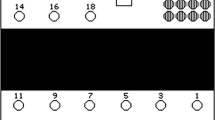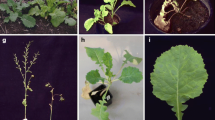Abstract
Green peach aphids (Myzus persicae (Sulzer) ) pose a threat to the Idaho potato (Solanum tuberosum L.) crop primarily because they transmit potato leafroll virus (PLRV). Only colonizing vectors are epidemiologically significant because PLRV is persistently transmitted. Additionally, Idaho winters are severe enough that most permanently anholocyclic aphid species do not establish. It is now accepted that the taxon that has been known asMyzus (Nectarosiphon)persicae (Sulzer) is in fact at least three species (M. persicae, Myzus nicotianae Blackman andMyzus antirrhinii (Macchiati) ). It was not known whether the newly designated species had the potential to damage the Idaho potato crop. The objectives of our research were to determine whetherMyzus (Nectarosiphon) spp. other thanM. persicae occurred naturally in Idaho, whether they could colonize potato and transmit PLRV, and whether they were potentially holocyclic.
NoMyzus (Nectarosiphon) spp. other thanM. persicae were found in Idaho in trap nurseries; howeverMyzus ascalonicus Doncaster recently has been found on stored bulbs and in suction trap collections in north Idaho. Laboratory bioassays for PLRV vector potential usingPhysalis floridana Rydb. indicator plants show thatM. nicotianae can transmit PLRV as efficiently asM. persicae. Similarly,M. nicotianae colonized potato as well asM. persicae in a replicated laboratory experiment comparing two clones ofM. nicotianae and one clone ofM. persicae. Our observations indicate that North AmericanM. nicotianae may be capable of a limited facultative holocycle. Thus, in laboratory experiments,M. nicotianae is as damaging asM. persicae with respect to PLRV vector potential; however,M. nicotianae may not occur naturally in areas like Idaho that have no tobacco production. A summary of allMyzus (Nectarosiphon) spp. with respect to PLRV epidemiology is provided.
Compendio
Los áfidos verdes del melocotonero [Myzuspersicae (Sulzer) ] representan un problema para el cultivo de papa (Solanum tuberosum L.) de Idaho debido principalmente a que ellos transmiten el virus del enrollamiento de la hoja de la papa (PLRV). Sólo los vectores que constituyen colonias son epidemiológicamente significativos debido a que elPLRV es persistentemente transmitido. Adicionalmente, los inviernos de Idaho son suficientemente severos de manera a que la mayoría de las especies de áfidos permanentemente anholocíclicas no se establecen. Se acepta ahora que el taxon que fuera conocido comoMyzus (Nectarosiphon)persicae (Sulzer) representa por lo menos tres especies [M. persicae, Myzus nicotianae Blackman yMyzus antirrhinii (Macchiati) ]. No se conocía si las especies designadas recientemente tenían el potencial para dañar el cultivo de papa en Idaho. Los objetivos de la investigación fueron determinar si las especies deMyzus (Nectarosiphon) diferentes aMyzus persicae ocurren naturalmente en Idaho, si ellas pueden colonizar a la papa y transmitir el PLRV y si eran potencialmente holocíclicas.
No se encontraron en los semilleros trampa, en Idaho, especies deMyzus (Nectarosiphon) diferentes alMyzus persicae, sin embargo, se ha encontrado recientemente en el norte de Idaho alMyzus ascalonicus Doncaster en bulbos almacenados y recolecciones en trampas de succión. Bioensayos de laboratorio para determinar el potencial de los vectores del PLRV, utilizandoPhysalis floridana Rydb. como planta indicadora, muestran queM. nicotianae puede transmitir el PLRV tan eficientemente como elM. persicae. Similarmente,M. nicotianae colonizó a la papa tan bien como elM. persicae en un experimento de laboratorio con repeticiones en el que se compararon dos clones deM nicotianae con un clon deM. persicae. Las observaciones indican que elM. nicotianae norteamericano puede ser capaz de un holociclo facultativo limitado. Así, an experimentos de laboratorio, elM. nicotianae es tan dañino como elM. persicae en relación al potencial como vector del PLRV; sin embargo,M. nicotianae puede no ocurrir naturalmente en zonas como Idaho en donde no se produce tabaco. Se presenta un resumen de todas las especies deMyzus (Nectarosiphon) en relación a la epidemiología del PLRV
Similar content being viewed by others

Literature Cited
Beemster, A.B.R. and A. Rozendaal, 1972. Potato viruses: properties and symptoms. Pages 115–143In: J.A. de Bokx, ed, Viruses of potatoes and seed potato production. Wageningen: Centre for Agricultural Publication and Documentation.
Bishop, G.W. and J.W. Guthrie. 1964. Home gardens as a source of green peach aphid and virus disease in Idaho. Am Potato J 41:28–34.
Blackman, R.L. 1987. Morphological discrimination of a tobacco-feeding form fromMyzus persicae (Sulzer) (Hemiptera: Aphididae), and a key to New WorldMyzus (Nectarosiphon) species. Bull of Entomol Res 77:713–730.
Blackman, R.L. and V.F. Eastop. 1984. Aphids on the world’s crops. John Wiley & Sons, Chichester, New York, Brisbane, Toronto and Singapore. 466 pp.
Blackman, R.L. and A.J.C. Paterson. 1986. Separation ofMyzus (Nectarosiphon)antirrhinii (Macchiati) fromMyzus (N.)persicae (Sulzer) and related species in Europe (Homoptera: Aphididae). Systematic Entomology 11:267–276.
Blackman, R.L. and J.M. Spence. 1992. Electrophoretic distinction between the peach- potato aphid,Myzus persicae, and the tobacco aphid,Myzus nicotianae (Homoptera: Aphididae). Bull Entomol Res 82:161–165.
Boiteau, G. and D.T. Lowery. 1989. Comparison of a yellow form of the green peach aphid,Myzus persicae (Sulzer) and a green form of the tobacco aphid,Myzus nicotianae Blackman, coexisting on greenhouse potato in New Brunswick. Can Entomol 121:1029- 1035.
Casper, R. 1988. Luteoviruses. Pages 235–258In: R. Koenig, ed., The Plant Viruses. Plenum.
Clark, M.F. and A.N. Adams. 1977. Characteristics of the microplate method of enzyme linked immunosorbent assays for the detection of plant viruses. J Gen Virol 34:475- 483.
Clark, M.F. and A.F. Ross. 1964. Variation among clones ofMyzus persicae in ability to transmit potato leafroll acquired by injection. Phytopathology 54:199–204.
Eastop, V.F. and D. Hille Ris Lambers. 1976. Survey of the World’s Aphids. Junk, The Hague. 573 pp.
Gittins, A.R., G.W. Bishop, G.F. Knowlton and E.J. Parker. 1976. Aphids of Idaho. Idaho Agric Exp Sta Res Bulletin #95. University of Idaho, Moscow. 47 pp.
Hille Ris Lambers, D. 1955. Potato aphids and virus diseases in the Netherlands. Ann Appl Biol 42:355–360.
Hille Ris Lambers, D. 1966. Notes on California aphids, with descriptions of new genera and new species. Hilgardia 37:569–623.
Hille Ris Lambers, D. 1972. Aphids: their life cycles and their role as virus vectors. Pages 35–56In: J.A. de Bokx, ed., Viruses of potatoes and seed potato production. Wageningen: Center for Agricultural Publication and Documentation.
Kennedy, J.S., M.J. Day and V.F. Eastop. 1962. A Conspectus of Aphids as Vectors of Plant Viruses. Commonwealth Inst Entomol, London. 114 pp.
Kolesova, D.A., V.G. Kuznetsova, and G. Ch. Shaposhnikov. 1980. Clonal variability in peach aphid,Myzus persicae (Hemiptera: Aphididae). Ann Entomol Soc Am 71:809- 812.
MacCarthy, H.R. 1954. Aphid transmission of potato leafroll virus. Phytopathology 44:167- 174.
Myazaki, M. 1971. A revision of the tribe Macrosiphini of Japan (Homoptera: Aphididae, Aphidinae). Insecta Matsumurana, J Faculty Agric, Hokkaido Univ 34:1–247.
Narzikulov, M.N. 1957. New plant lice (Homoptera: Aphididae) from the mountain regions of Tadjikistan. Rev Entomol URSS 30:671–694.
National Potato Council. 1992. Potato Statistical Yearbook. National Potato Council, Englewood, CO. 71 pp.
Nielsson, RJ. 1971. The taxonomy of the Myzini (Homoptera: Aphididae) of the Eastern United States. Ph.D. Dissertation. Univ of Florida.
Pavek, J.J., D.L. Corsini, S.L. Love, D.C. Hane, D.G. Holm, W.M. Iritani,S.R. James, M.W. Martin, A.R. Mosley, J.C. Ojala, CE. Stanger and R.E. Thornton. 1991. Frontier Russet: A new potato variety for early fresh and processing use with resistance to fusarium dry rot. Am Potato J 68:525–532.
SAS Institute. 1985. SAS User’s Guide: Statistics. SAS Institute, Cary, N.C.
Scheller, H.V. and R.H. Shukle. 1986. Feeding behavior and transmission of barley yellow dwarf virus bySitobion avenae on oats. Entomol Exp App 40:189–195.
Shands, W.A., G.W. Simpson and H.E. Wave. 1969. Canada plum,Prunus nigra Aiton, as a primary host of the green peach aphid,Myzus persicae (Sulzer), in northeastern Maine. Univ Maine Tech Bull #39, 32 pp.
Stubbs, L.L. 1955. Strains ofMyzus persicae (Sulz.) active and inactive with respect to virus transmission. Austral J of Biol Sci 8:68–74.
Swenson, K.G. 1968. Role of aphids in the cology of plant viruses. Ann Rev Phytopathol 6:351–374.
Takada, H. 1986. Genotypic composition and insecticide resistance of Japanese populations ofMyzus persicae (Sulzer) (Horn., Aphididae). Z Angew Entomol 102:19–38.
Tamada, T., B.D. Harrison and I.M. Roberts. 1984. Variation among British isolates of potato leafroll virus. Ann Appl Biol 104:107–116.
Upreti, G.C. and B.B. Nagaich. 1971. Variations in the ability ofMyzus persicae Sulz. to transmit potato viruses. I. leafroll. Phytopathol Z 71:163–168.
van Emden, H.E., VF. Eastop, R.D. Hughes and M.J. Way. 1969. The ecology ofMyzus persicae. Ann Rev of Entomol 14:197–270.
Author information
Authors and Affiliations
Rights and permissions
About this article
Cite this article
Halbert, S.E., Castle, S.J. & Mowry, T.M. Domyzus (nectarosiphon) species other thanm persicae pose a threat to the idaho potato crop?. American Potato Journal 72, 85–97 (1995). https://doi.org/10.1007/BF02987282
Accepted:
Issue Date:
DOI: https://doi.org/10.1007/BF02987282



